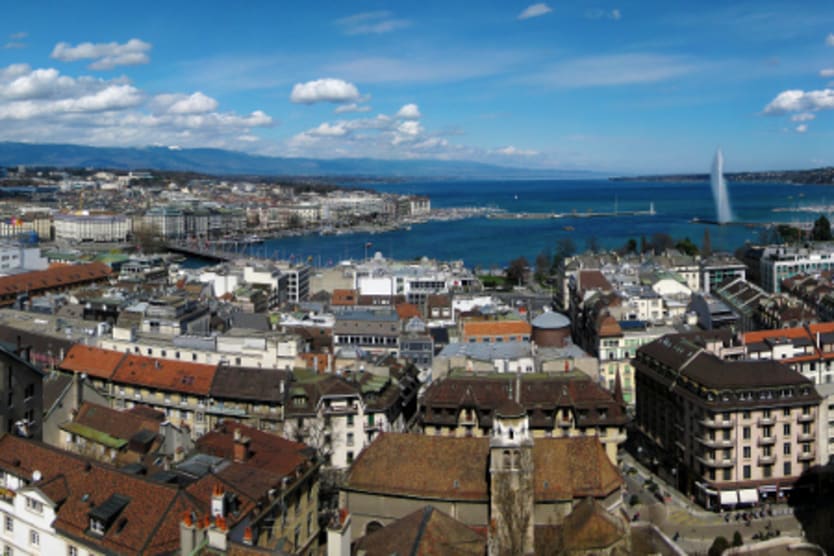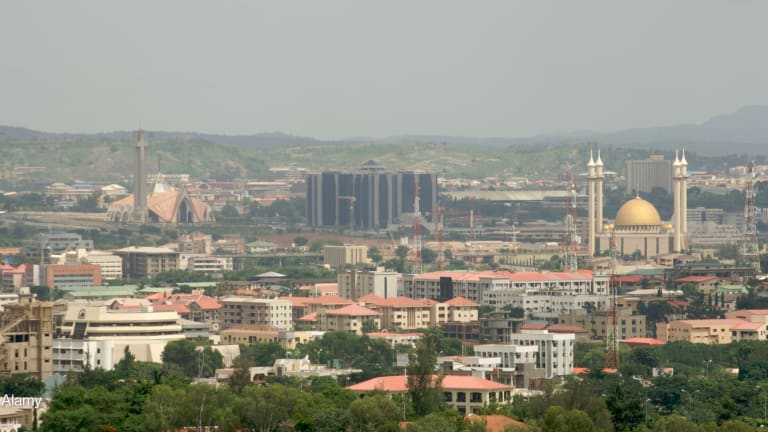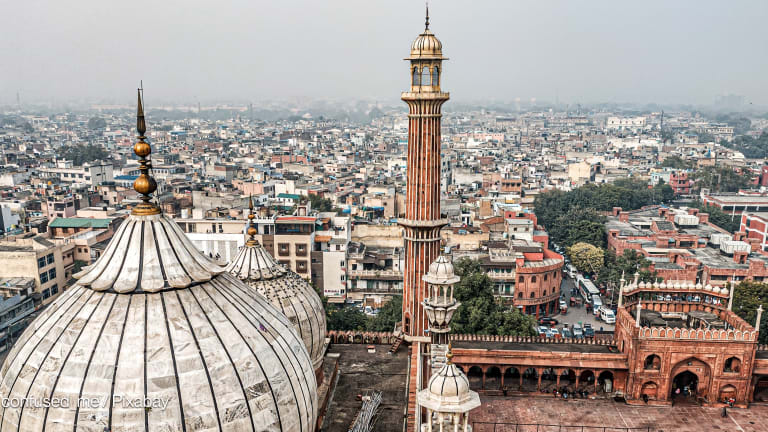
Geneva isn’t just one of the world’s largest financial hubs, it is also the No. 1 United Nations city, playing host to around 8,500 U.N. employees.
And that’s not all. Three global health-related public-private partnerships and two Nobel Peace Prize-winning nonprofits are managed from Geneva.
Given the magnitude of these organizations’ international operations, the Swiss city has become home to an extremely large expatriate community. In April 2011, foreign nationals numbered almost 89,000, nearly half of the city’s population.
>> Learn more about finding work and living in Geneva
Here are the largest Geneva-based organizations engaged in humanitarian and development work and international cooperation. Visit the Devex jobs board for the latest vacancies in Geneva and beyond.
Aga Khan Development Network
Type: network of development and nonprofit organizationsFounded: 1967The Aga Khan: Shāh Karīm al-ḤussaynīEmployees: 80,000 worldwide, with the majority in developing countries
AKDN comprises 11 institutions, including the Aga Khan Foundation, with individual mandates focusing on specific fields such as health, education, rural development and the promotion of private sector enterprise, which together aim to achieve a common goal: build institutions and programs that can address social, economic and cultural challenges. It works in 30 countries. In 2010, AKDNallocated $620 million to nonprofit development activities. The companies supported by the Aga Khan Fund for Economic Development generated $2.3 billion in the same year, with surpluses reinvested in development activities. In 2011, AKDN was named a Devex Top 40 Development Innovator.
Global Alliance for Improved Nutrition
Type: international foundation and public-private partnershipFounded: 2002Executive director: Marc Van AmeringenEmployees: 80 worldwide
Created during a special session of the U.N. General Assembly on children, GAINinvests in and works with more than 600 firms involved in 36 large-scale partnerships in 25 countries, delivering nutritionally enhanced food products to 400 million people, half of whom are women and children. Its goal is to bring fortified food with sustainable nutritional impact to more than 1 billion people. GAIN is supported by several high-profile private and public donors such as the Bill & Melinda Gates Foundation, Canadian International Development Agency, the Dutch government, U.S. Agency for International Development and Wellcome Trust.
Global Alliance for Vaccines and Immunization
Type: public-private partnershipFounded: 2000Interim CEO: Helen Evans Employees: 124 in Geneva and Washington, D.C. (2010)
The GAVI Alliance aims to increase access to vaccines in the world’s poorest countries. Its members include developing world and donor governments, the financial community, vaccine manufacturers, civil society organizations, research and technical institutes, multilateral agencies such as the World Health Organization, UNICEF and the World Bank, and private charities such as the Bill & Melinda Gates Foundation. Since its launching, GAVI has helped immunize 288 million children; according to WHO, GAVI’s assistance, by the end of 2010, had directly averted more than 5 million future deaths from hepatitis B, Hib, pertussis, measles, yellow fever and polio.
Global Fund to Fight AIDS, Tuberculosis and Malaria
Type: international financing institution and public-private partnershipFounded: 2002Executive director: Michel KazatchkineEmployees: 569 (end of 2009)
Multilateral negotiations led to the creation of the Global Fund, which is supported by governments around the world as well as international figures such as billionaire philanthropist Bill Gates, musician and anti-poverty campaigner Bono and French first lady Carla Bruni-Sarkozy. Since its inception, the Global Fund has invested $21.7 billion in large-scale prevention, treatment and care programs against the three diseases in 150 countries. It has no country-level presence; projects are instead pre-selected, in each country, by a panel of government and civil society stakeholders.
International Committee of the Red Cross
Type: non-governmental organizationFounded: 1863President: Jakob KellenbergerEmployees: more than 1,400 on international field missions, plus 11,000 local employees and 800 at headquarters
ICRC is an impartial, neutral and independent organization whose humanitarian mission is focused on protecting and providing assistance to victims of international war and internal violence. It is the oldest member of the International Red Cross and Red Crescent Movement. ICRC has won three Nobel Peace Prizes, in 1917, 1944 and 1963.
International Labor Organization
Type: U.N. specialized agencyFounded: 1919Director-general: Juan SomaviaEmployees: 2,700 at headquarters and 40 field offices (staff of International Labor Office)
ILO is the first specialized agency of the United Nations. It has a tripartite structure, which brings together government, business and workers’ representatives from its 183 member states to formulate policies and programs that uphold rights at work and promote decent employment. The International Labor Office serves as the permanent secretariat and focal point for overall activities of ILO.
International Organization for Migration
Type: intergovernmental organizationFounded: 1951Director-general: William Lacy SwingEmployees: more than 7,000 staff working on more than 2,820 projects
IOM works with its partners, ranging from governments, intergovernmental organizations, NGOs, the research community and private sector, to promote humane and orderly migration. It has 32 member states. IOM holds an observer status at the U.N. General Assembly.
Médecins Sans Frontières Switzerland
Type:NGOFounded: 1981Director-general: Christian CaptierEmployees: 140 full-time, 2,730 national MSF employees and 620 international volunteers worked in the 20 countries in 2009
MSF Switzerland is one of 19 organizations that make up the Nobel Peace Prize-winning MSF International. It provides emergency medical assistance to victims of natural and man-made disasters and armed conflict. Its teams are mainly composed of doctors and other health professionals. MSF Switzerland has projects in 19 countries in Africa, Asia, Latin America and the Caribbean, and the Middle East.
ORT International Cooperation
Type: Nonprofit training agencyFounded: 1960Director: Daniel Khan
ORT International Cooperation is part of World ORT, the world’s largest network of non-governmental education and training organizations. It has implemented more than 350 projects in nearly 100 countries upon the request of international agencies, host government and private firms. It renders technical assistance in establishing self-sustaining, local training capacity by engaging host governments, civil society groups and beneficiaries in defining project objectives. In addition to providing training, it performs studies on improving technical and vocational education in developing countries.
SGS
Type: consultancyFounded: 1878CEO: Chris KirkEmployees: more than 64,000
SGS is a global leader in inspection, verification, testing and certification services. It operates a network of 1,250 offices and laboratories worldwide. It performs NGO benchmarking, which assesses an NGO’s conformity to internationally recognized best practices in management, especially in terms of transparency, integrity and performance. SGS reported a total revenue of 4.8 billion Swiss francs ($5.6 billion) in 2010.
United Nations Office at Geneva
Type: U.N. duty stationFounded: 1966Director-general: Kassym-Jomart TokayevEmployees: more than 1,600
UNOGserves as the representative office of the U.N. secretary-general in Geneva. It is the largest U.N. duty station outside the global body’s headquarters in New York and is one of the world’s busiest conference centers, servicing more than 8,000 meetings per year. UNOG renders financial and administrative support services to more than 20 Geneva-based U.N. organizations departments as well as agencies located in Bonn and Turin.
United Nations Office for the Coordination of Humanitarian Affairs
Type: international interagency and U.N. body Founded: 1991Undersecretary-general and emergency relief coordinator: Valerie AmosEmployees: around 1,900
OCHA provides leadership in coordinating response of humanitarian actors to emergencies. It draws funding from three pooled funds to enable its national and international partners to immediately provide lifesaving relief during crises, such as food, water and shelter following national disasters as well as nutrition and medical care for babies born in refugee camps. Donors to OCHA include 23 of the richest countries and the European Commission.
World Economic Forum
Type: nonprofit foundationFounded: 1971Founder and executive chairman: Klaus SchwabEmployees: almost 400
The World Economic Forum brings together leaders from the corporate world, governments, academe and other segments of society who are “committed to improving the state of the world.” Its funding comes from fees for memberships, partnerships and participation to its annual and regional meetings. A typical forum member is a global enterprise with turnover exceeding $5 billion, according to the organization’s website. Its annual meetings in Davos attract 2,500 attendees who debate emerging global issues and identify ways to address them. These meetings are not open to the public due to security reasons, but the forum co-organizes with civil society groups an open forum that is held in Davos simultaneously with the annual summit and is open to the general public, free of charge.
World Health Organization
Type: U.N. specialized agencyFounded: 1948Director-general: Margaret ChanEmployees: some 8,500 people in 147 country offices
Aside from providing leadership on all matters related to global health, WHO is responsible for shaping the health research agenda, setting norms and standards, articulating ethical and evidence-based policy options, rendering technical support to countries, and monitoring and studying health trends. These core functions are outlined in its 11th general program of work, covering the 10-year period from 2006 to 2015. WHO produces the World Health Report, which offers expert assessment on a global health topic in a bid to assist governments, donor agencies and international organizations in making policy and funding decisions. The latest in the series, published in 2010, tackles health systems financing.
Other notable aid and international cooperation organizations with presence in Geneva
Office of the United Nations High Commissioner for Human Rights
United Nations International Strategy for Disaster Reduction
United Nations Relief and Works Agency for Palestine Refugees in the Near-East
United Nations System Chief Executives Board for Coordination
Did we forget any major aid organization based in Geneva? Please let us know by placing your comments below.








